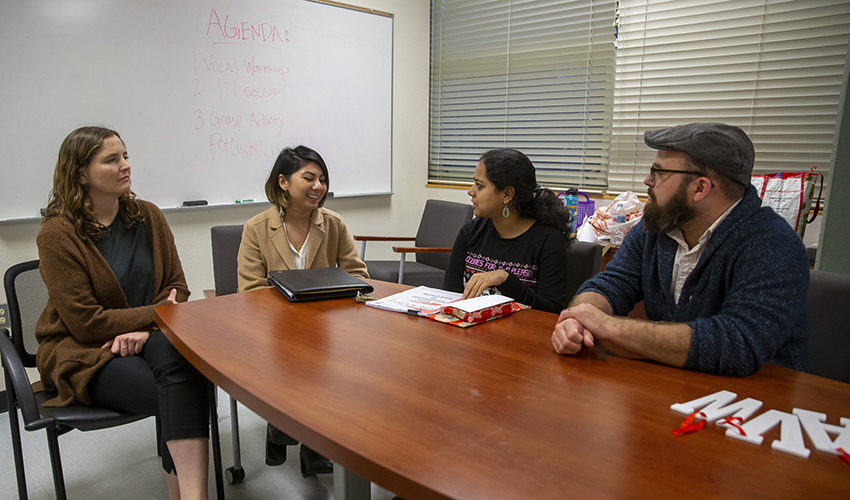SF State clinic helps transgender, nonbinary people find their voice

Anusha Sundarrajan (second from right) and her graduate student clinicians Eliza Lasky (from left), Suttera Samonte and Mitchell Peck discussing therapy plans for a future session.
Participants use speech therapy to identify a voice that matches gender expression
Imagine how you’d feel if your voice didn’t sound like you — if every time you spoke you heard a voice that didn’t align with who you are. Many transgender and nonbinary people don’t have to imagine this scenario, because it’s all too common for them.
This experience often leads to them being misgendered, which is describing a person in a way that doesn’t align with their gender identity, in everyday situations like talking on the phone or giving a presentation. Understanding how unsettling this can be, one San Francisco State University professor is helping trans and nonbinary people find their voice through speech therapy techniques.
Assistant Professor of Speech, Language and Hearing Sciences Anusha Sundarrajan launched a speech therapy program last fall semester that teaches strategies for achieving a gender-affirming voice. The goal of the clinic: help participants identify and speak with a voice that matches their gender expression.
“With our clinic, we provide a nonjudgmental space where our participants can find a voice that defines who they are,” Sundarrajan said. “We want to create a safe and open environment for all our participants.”
Some trans and nonbinary people change their voice without formal training, which can strain and harm their vocal cords, she points out. Sundarrajan emphasized that the clinic teaches safe, healthy and sustainable methods for participants to achieve their desired voice.
Sundarrajan and a team of graduate student clinicians meet with participants weekly to explore natural techniques of voice modification. Each session kicks off with group warm-up exercises — like humming through a straw to strengthen the vocal cords — followed by one-on-one time between the clinicians and participants under the supervision of Sundarrajan.
The clinic takes a personalized, patient-centered approach by assigning a clinician to each participant. In the early stages of the program, clinicians focus on getting to know participants, where they are in their transition and what they want their voice to sound like. From there, each clinician develops a customized therapy plan for their assigned participant.
Sundarrajan stresses that clinicians do not seek to define what is considered a masculine or feminine voice. “We want to say to our participants, ‘Hey, is this how you want to sound? Okay, we’ll give you the techniques to get you there,’” she said.
To reach their goals, participants use techniques common in the field of speech-language pathology. For example, clinicians employ Conversation Training Therapy, which helps participants comfortably speak with their target voice in a conversational setting. One exercise of this type of therapy involves switching between their current and target voice, a practice that builds their confidence in speaking with their target voice in everyday settings.
Lola Chase, a recent San Francisco State graduate who is transmasculine (assigned as female at birth, but identifies on the male side of the gender spectrum), joined the clinic when it first launched. He calls the program a success. Before treatment, Chase says he found his voice limiting because it did not represent his identity. After attending the sessions, Chase noticed it felt more natural speaking in a voice that felt true to him.
“Prior to joining the clinic, I didn’t know how to support my voice in a way that both aligns with my gender identity and is healthy,” Chase said. “I learned a lot from the clinic in that sense.”
According to Chase, what he learned boosted his confidence as a journalist and spoken-word poet — two practices that involve a lot of speaking. As he sees it, the clinic does more than help participants feel better about how they sound. It can help them feel more accepted and included where they’re at.
“This type of clinic reassures queer people that we have a place on campus and that we are being seen and heard,” he said. “That’s really special to us.”
Members of the campus community and general public can apply to be a participant, with priority given to enrolled SF State students. For more information, contact Anusha Sundarrajan via email.